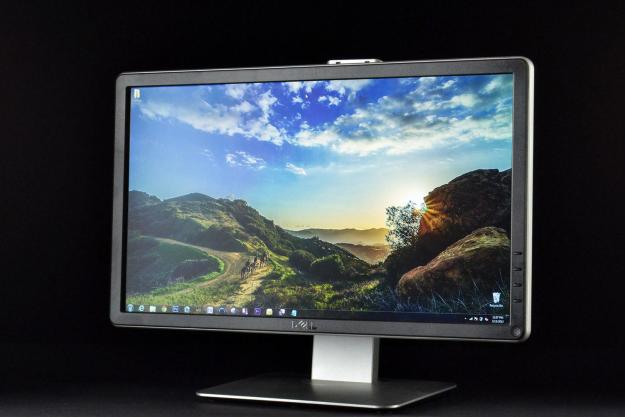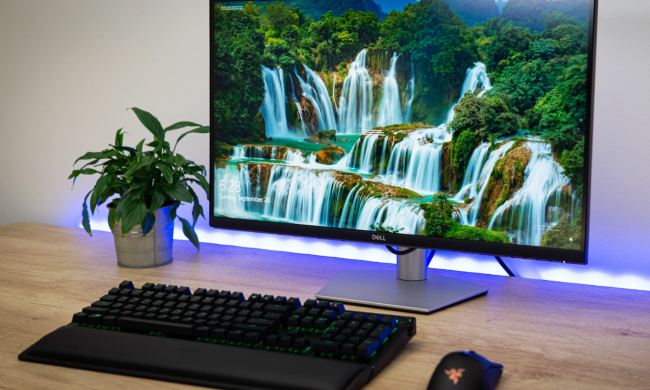
“Dell’s P2014Ht justifies its high pricing with great image quality and a highly adjustable stand that provides perfect ergonomics.”
- Highly adjustable stand
- Easy-to-use display controls
- Great image quality
- Very bright
- No precise color temperature controls
- Expensive
Big monitors receive all the attention, not only because they’re large, but also because they’re expensive. There’s always a tendency for technology companies to promote their latest and greatest, even if most consumers actually end up with the model that’s a step down.
The P2014Ht is the top pick among small monitors.
Sometimes, though, we have the chance to test a budget workhorse, and the Dell P2014Ht is undoubtedly an example of such. This small 20-inch, 1600 x 900 monitor is tiny by modern standards, yet it’s no barebones display for buyers with light wallets. This display has an IPS panel, a fully adjustable VESA compatible stand and significant input support, traits that in theory make it usable for professional photo and document editing, as well as more casual pursuits.
These features do bump up the price, however, putting the P2014Ht at $239. While that’s not going to empty out the average buyer’s savings, it is a lot to ask for a 20-inch monitor. Displays of similar size sell for as little as $100 at many retail stores, so this Dell needs to offer better than average performance. Let’s see if a small, quality monitor makes sense next to cut-rate competitors.
Workhorse
While Dell makes many monitors, most of them are framed by a thin black bezel that’s slightly elevated above the surface of the panel. This is a rather old-school look that’s ditched only by the company’s handful of touchscreen alternatives, which have edge-to-edge glass, but that doesn’t mean the P2014Ht is excessively thick or heavy. Think of it like a work uniform; not stylish, but certainly functional.
The same can be said of the excellent ergonomic stand. Though coated in unattractive silver plastic the stand provides excellent stability and all the adjustments we could ask for; tilt, swivel, rotation and height. Want to work on a large document, but find the 1600 x 900 display to be vertically constraining? Just rotate the display 90 degrees and use it as a 900 x 1600 monitor instead.
All of the input ports are wisely positioned well below where the stand connects to the monitor, which means cables don’t catch as the display is adjusted. Video input options include VGA, DVI and DisplayPort, but not HDMI, a decision which will be a minor obstacle for anyone who wants to connect a game console or media player. USB ports are also included on the monitor, but devices can only be attached to the rear port panel; there are no connections along the flanks. Many users will simply ignore those ports because plugging a drive into a connected desktop or laptop is quicker.
Easy but limited adjustments
The 2014ht uses Dell’s typical on-screen display controls, which can be navigated via four physical buttons on the lower right bezel. These buttons correspond to the control menu itself, and the labels change depending on context, which makes adjustment quick and intuitive.

Meaningful change can be hard to make, however, because only basic brightness, contrast and color balance controls are available. Color temperature adjustment is generally restricted to the Ultrasharp line and so the 2014ht, despite the potential of its IPS panel, has to make do with “cool” and “warm” presets. The other preset modes seem to work a bit better here than they did on the larger Dell P2714T, but professionals will surely ignore them in favor of their own calibration.
A small wonder
The 2014ht’s display quality is a gigantic leap forward relative to a typical budget-priced small monitor. Our test equipment showed the display managing a maximum contrast ratio of 650:1 straight out of the box, and credit for that result can be given to brightness and black levels in equal measure.
At 50 percent brightness, which is about where the display should be set in a dimly lit room, this panel’s black level is roughly twice as dark as the much more expensive Samsung Series 9 monitor we recently reviewed. Yet the display pushes 330 lux at full brightness which, combined with the matte finish, makes the display usable in all but the most severe lighting conditions.
Think of it like a work uniform; not stylish, but certainly functional.
Color accuracy came in at an average delta error of 2.5, which is good but not excellent. While blue was the biggest offender, recording a deltaE of 6, all other colors displayed an error above one and many were above two. Gamma was very close to perfect, however, coming in at 2.1 relative to the target of 2.2.
Color errors aside, we found the display’s out-of-the-box picture pleasing. The high contrast ratio provides images and media with a sense of depth and the colors, though not perfect, are good enough to provide a rich and mostly life-like look. The main issue, as with so many LED backlit monitors, is a bluish tone that casts a cold, sterile sheen over content.
Users shouldn’t worry about resolution, either. Though sub-1080p is not popular in today’s market, 1600 x 900 is a great resolution for a monitor of this size. More pixels would likely cause Windows to suffer scaling issues and might ruin the experience for users with poor eyesight.
Calibration makes it better
Our calibration tools had little impact on headline traits like contrast, black depth and brightness, all of which remained almost exactly as before. We did see major movement in color accuracy, however, which dropped down to an average deltaE of 1.63. An error below one is generally undetectable by the human eye, so while this result is not perfect, it is close. Gamma also reached the ideal target of 2.2.

Better color translated to noticeably better image quality, particularly in regard to the cool tone which troubles the un-calibrated panel. Though there’s still some hint of bluish hue in bright scenes or pure-white documents, flesh tones look warmer and colors are more realistic. When placed next to most small displays, there’s simply no comparison; the calibrated P2014t dominates by every measure.
Conclusion
The Dell P2014Ht is an excellent small monitor for anyone who is interested in good image quality and excellent ergonomic adjustability. We’re actually a bit puzzled as to why Dell didn’t go the extra mile and make this an Ultrasharp, as the quality of the panel seems sufficient.
We do wonder at the price, however. Anything above $200 is a lot to pay for any small display, and consumers will no doubt be concerned that no 20-incher is worth this much money. Stranger still is the fact that Dell’s own Ultrasharp U2312HM is currently going for $229, ten bucks less than the P2014Ht.
Many consumers are going to look at the cost of this monitor and rightly make a bee-line for a larger model. That’s not a poor decision, as a 20-inch screen does look very small on a modern desktop. For those who want a quality small monitor, however, the P2014Ht is a top pick.
Highs
- Highly adjustable stand
- Easy-to-use display controls
- Great image quality
- Very bright
Lows
- No precise color temperature controls
- Expensive







